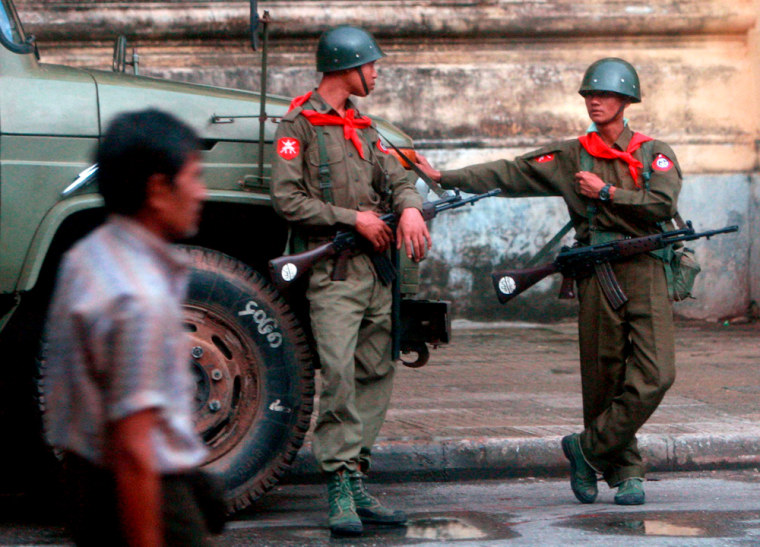One hundred shot dead outside a Myanmar school. Activists burned alive at government crematoriums. A Buddhist monk floating face down in a river.
After last week’s brutal crackdown by the military, horror stories are filling Myanmar blogs and dissident sites. But the tight security of the repressive regime makes it impossible to verify just how many people are dead, detained or missing.
“There are huge difficulties. It’s a closed police state,” said David Mathieson, a consultant with Human Rights Watch in Thailand. “Many of the witnesses have been arrested and are being held in areas we don’t have access to. Other eyewitness are too afraid.”
Authorities have acknowledged that government troops shot dead nine demonstrators and a Japanese cameraman in Yangon. But witness accounts range from several dozen deaths to as many as 200.
The Myanmar regime reports 10 people dead and 6,000 detained.
“We do believe the death toll is higher than acknowledged by the government,” Shari Villarosa, the top U.S. diplomat in Myanmar, told The Associated Press Monday. “We are doing our best to get more precise, more detailed information, not only in terms of deaths but also arrests.”
Villarosa said her staff had visited up to 15 monasteries around Yangon and every single one was empty. She put the number of arrested demonstrators — monks and civilians — in the thousands.
“I know the monks are not in their monasteries,” she said. “Where are they? How many are dead? How many are arrested?”
She said the true death toll may never be known in a Buddhist country where bodies are cremated.
“We’re not going to find graves like they did in Yugoslavia ... We have seen few dead bodies. The bodies are removed promptly. We don’t know where they are being taken,” Villarosa said.
Groups collect witness accounts
Dissident groups have been collecting accounts from witnesses and the families of victims, and investigating reports of dead bodies turning up at hospitals and cemeteries in and around Yangon.
The U.S. Campaign For Burma, a Washington-based pro-democracy group, says more than 100 people were killed in downtown Yangon after truckloads of government troops fired automatic weapons last Thursday at thousands of demonstrators. It also claims that 100 students and parents were killed the same day at a high school in Tamwe, in northeastern Yangon, after troops shot at them as school let out.
The Democratic Voice of Burma, a Norway-based dissident news organization, has received reports of soldiers burning protesters alive at the Yae Way cemetery crematorium on the outskirts of Yangon. The group also shot video Sunday of a dead monk, badly beaten and floating face down in a Yangon river.
The Democratic Voice of Burma has put the death toll at 138, based on a list compiled by the 88 Student Generation, a pro-democracy group operating in Myanmar.
“This 138 figure is quite credible because it’s based on names of victims,” Aye Chan Naing, the chief editor, told the AP Monday. “I also think the figure is accurate because of the pictures coming from inside Burma. The way they were shooting into the crowds with machine guns means dozens of people could have died.”
6,000 protestors jailed, group estimates
The Democratic Voice of Burma also estimates that about 6,000 demonstrators — including at least 1,400 monks from seven now-empty monasteries — are being held at makeshift detention centers set up at universities, old factories and a race track in Yangon. There are already an estimated 1,100 political prisoners languishing in Myanmar’s jails.
The military junta did not respond to AP requests for comment Monday. It is impossible to independently verify the death toll because Myanmar is virtually off-limits to journalists.
Lars Bromley of the American Association for the Advancement of Science in Washington said his agency has ordered up satellite images of four Myanmar cities, including Yangon, since the crackdown. He said satellite imagery — along with clear skies and exact locations from witnesses — could help locate massacre sites, and also give some sense of the military presence around cities and monasteries.
“If there are several suspected burial sites, we could help narrow it down or identify the site,” said Bromley, who last week uncovered evidence that Myanmar’s military destroyed border villages and forcibly relocated ethnic minorities in eastern Myanmar last year. “But we need a little information to go on.”
Exact toll may never be known
Most analysts said the fallout from the protests was not surprising, given the regime’s history of brutality. It may be impossible to ever verify how many people are dead or detained.
“We cannot say exactly and we are unlikely to know for sure,” Win Hlaing of the dissident group National League for Democracy-Liberated Area said of the death toll. “(But) the junta never declares the real number of people killed.”
Myanmar’s military also opened fire on the country’s 1988 democratic uprising. Human Rights Watch estimates that at least 3,000 protesters were killed, but other reports cite up to 10,000.
The media, diplomats and activists have been denied access to documents that could shed light on the shootings.
And so, to this day, the exact death toll remains shrouded in secrecy.
